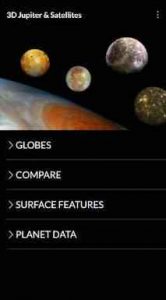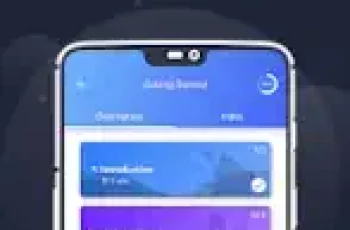[App] Jupiter and Moons 3D

Jupiter & Moons 3D displays interactive globes of Jupiter and moons that you can compare, rotate and zoom.
Includes the four largest satellites: Io, Europa, Ganymede and Callisto. Globes feature Visible Surface and Geological maps.
It’s 100% free (with ads) and available on Google Play:
play.google.com/store/apps/details?id=jupiterpocket.moonrover.com
It’s possible to compare with side by side views:
Surface of Jupiter, Io, Europa, Ganymede and Callisto.
Relative sizes of the Moons
Relative sizes of the Moons and Jupiter
Visible surface features
Geology
Jupiter maps from Voyager and HST
You can overlay surface features labels on any of the globes.
There are also Tables with physical data about Jupiter, Io, Europa, Ganymede and Callisto.
Globes and data are based on real surface features from several space missions (Voyager, Cassini, Galileo, HST).
Jupiter is the fifth planet from our Sun and is, by far, the largest planet in the solar system – more than twice as massive as all the other planets combined. Jupiter’s stripes and swirls are actually cold, windy clouds of ammonia and water, floating in an atmosphere of hydrogen and helium. Jupiter’s iconic Great Red Spot is a giant storm bigger than Earth that has raged for hundreds of years.
Jupiter is surrounded by dozens of moons. Jupiter also has several rings, but unlike the famous rings of Saturn, Jupiter’s rings are very faint and made of dust, not ice.
Nine spacecraft have studied Jupiter up close. NASA’s Juno spacecraft is currently studying the gas giant planet from orbit. The spacecraft, which arrived at Jupiter in July 2016, is the first to study the planet’s mysterious, cloud-shrouded interior. Scientists also use the Earth-orbiting Hubble Space Telescope and ground-based telescopes to regularly check in on Jupiter.
Pioneer 10 was the first spacecraft to fly past Jupiter. It was followed by Pioneer 11, Voyager 1 and Voyager 2 flybys. NASA’s Galileo mission was first to orbit Jupiter and to send an atmospheric probe into the stormy clouds. The international Ulysses mission used Jupiter’s powerful gravity to hurl itself into orbital passes of the Sun’s northern and southern poles. Both Cassini and New Horizons studied Jupiter as they hurtled on to their main science targets — Saturn for Cassini and Pluto and the Kuiper Belt for New Horizons.
Two new missions are in the works to make close studies of Jupiter’s moons NASA’s Europa Clipper and ESA’s JUpiter ICy Moons Explorer (JUICE).
Jupiter holds a unique place in the history of space exploration. In 1610, astronomer Galileo Galilei used a new invention called the telescope to look at Jupiter and discovered the first moons known to exist beyond Earth. The discovery ended incorrect, ancient belief that everything, including the Sun and other planets, orbited the Earth.
With a radius of 43,440.7 miles (69,911 kilometers), Jupiter is 11 times wider than Earth. If Earth were the size of a nickel, Jupiter would be about as big as a basketball.
From an average distance of 484 million miles (778 million kilometers), Jupiter is 5.2 astronomical units away from the Sun. One astronomical unit (abbreviated as AU), is the distance from the Sun to Earth. From this distance, it takes Sunlight 43 minutes to travel from the Sun to Jupiter.
Jupiter and Moons 3D developer :
Download Jupiter and Moons 3D from Play Store
Thank to Moon Rover for sharing Jupiter and Moons 3D
You can find our crypto wallets on https://free-apps-android.com/buy-us-a-coffe/
Sponsored Links


